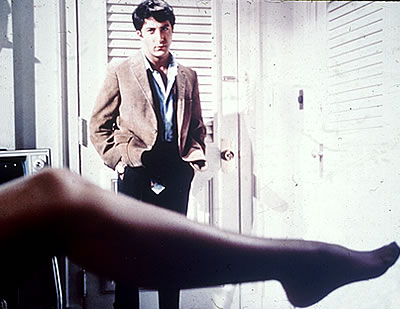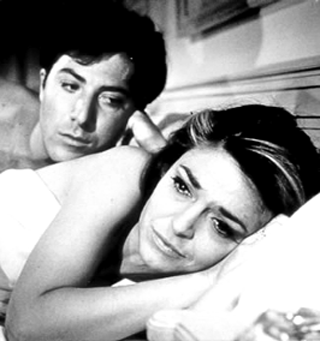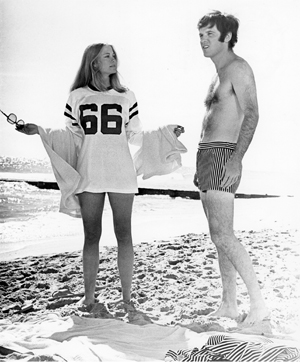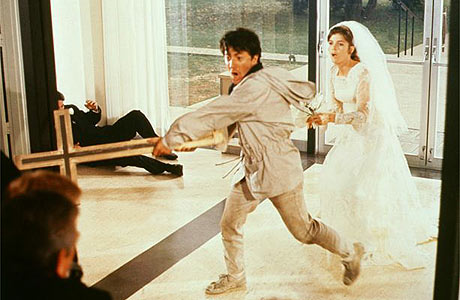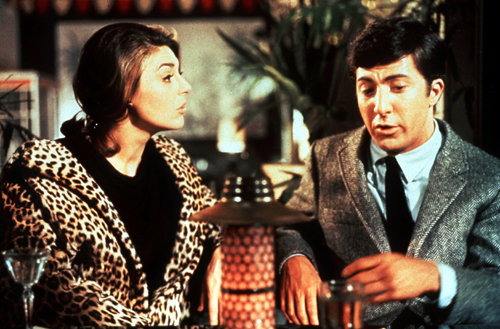This review originally appeared in the March 28, 1997 issue of the Chicago Reader.-— J.R.
The Graduate **
Directed by Mike NicholsWritten by Buck Henry and Calder WillinghamWith Anne Bancroft, Dustin Hoffman, Katherine Ross,William Daniels, MurrayHamilton, Elizabeth Wilson,and Brian Avery.
If I feel myself as the producer of my life, then I am unhappy. So I would rather be a spectator of my life. I would rather change my life this way since I cannot change it in society. So at night I see films that are different from my experiences during the day. Thus there is a strict separation between experience and the cinema. That is the obstacle for our films. For we are people of the 60s, and we do not believe in the opposition between experience and fiction. –- Alexander Kluge, 1988
The Graduate opened in December 1967, the same month the first successful human heart transplant was performed. It was a few weeks after the premiere of Bonnie and Clyde and about three months before the launching of 2001: A Space Odyssey. Among the albums that came out the same year were the Beatles’ Sgt. Pepper’s Lonely Hearts Club Band, the Rolling Stones’ Their Satanic Majesties Request, and the Mothers of Invention’s Absolutely Free. Simon and Garfunkel’s Sounds of Silence and Parsley, Sage, Rosemary and Thyme had both come out in ‘66, and The Graduate appropriated tracks from both of them on its sound track. (The “Mrs Robinson” lyrics were added for the sound track album.)
For many fans, including myself, of Mike Nichols and Elaine May who had seen them perform live or heard their ferociously funny records, Nichols’s early career as a director seemed tame, considering both his comic gifts and the political cast of the 60s. The Graduate, his second feature (his first was Who’s Afraid of Virginia Woolf? in ‘66) was entertaining, but hardly the rallying cry of a rebellious youth explosion that some claimed it to be once it took off at the box office (it was the second highest grossing movie of the 60s, after The Sound of Music). Even now, when new prints of the movie struck from the original internegative are being released, the only “revolutionary aspect” of The Graduate described in the press book is the use and impact of the Simon and Garfunkel songs -– not the songs themselves but the new marketing possibilities derived from transplanting “found” material into a Hollywood hit, which clearly set a lot of wheels spinning.
“She was always brave,” Nichols said of May during their partnership as a comedy team. “But I became more and more afraid.” This certainly appears to be the case if one compares their subsequent careers as directors. (For a candid look at the complex dynamics of their relationship during the height of their fame as a team, see Edmund Wilson’s posthumously published journals, The Sixties.) On the other hand, according to Janet Coleman in her book The Compass -– a fascinating study of the mid-50s Chicago improvisational comedy workshop from which Nichols and May sprang -– they both, along with comedian Shelley Berman, lost some of their edge when they became famous:
“On becoming stars, each member of the trio once referred to as ‘Two Cocksuckers and Elaine’ had unwittingly pulled some plugs from the main currents of ordinary life that had charged their improvisations with humanity. They had been almost instantly isolated from the ensemble work of their peers, the extraordinary improvisational foot soldiers. Thus, their passage into celebrity did not return to the political comedy of the improvisational theater any insights into the issues of status and money, or hard looks into the workings of power in the arts and society, or revelations about the entertainment industry. Without the focus and urgency of the improvisational theater, they were atomized from their most integrated and revealing work. Substituting for commonality and spontaneity the narcissism and obsessions of show business, they grew silent in the society they once had satirized.”
As a passionate fan of the four features May directed –- A New Leaf, The Heartbreak Kid, Mikey and Nicky, and Ishtar –– who finds plenty of “insights into the issues of status and money,” “hard looks into the workings of power in the arts and society,” and even a few “revelations about the entertainment industry” in these dark, vibrant movies, I feel that Coleman’s basically sound observation applies differently to the careers of May and Nichols. In many ways, May, unlike Nichols, is too large and unwieldy a talent to accommodate herself to the entertainment industry in a manner that can easily translate into fame and success, and given the complex and tortuous skirmishes she had with studios on all four of her features, it is hardly surprising that she has worked in Hollywood chiefly as an anonymous script doctor. More recently, she has teamed up with Nichols again as a writer on The Birdcage and, as reported in a lengthy article in the March 3 New York Observer, on an adaptation of Primary Colors budgeted at $65 million and starring John Travolta and Emma Thompson as the Clintons -– a project that seems highly political. It will be interesting to discover to what degree May’s dangerous satirical gifts and Nichols’s commercial savvy can work in tandem.
The Graduate, Nichols’s main ticket to mainstream success, replays various aspects of the Nichols-May partnership in telling ways –- as does The Heartbreak Kid (1972), May’s own second feature, which can be read in many ways as a response to The Graduate. Both movies chart the hero’s ditching of a dark, overpowering woman for an inaccessible WASP princess (each monomaniacally pursuing her to the university she’s attending, where he hangs out on the campus), echoing Nichols’s abandonment of the dangerous side of his routines with May. Furthermore, Charles Grodin, who plays the lead in The Heartbreak Kid, was originally cast by Nichols to play the lead in The Graduate, and Jeannie Berlin, who plays the ditched woman in The Heartbreak Kid, is May’s daughter.
The two movies take notably different approaches toward ethnicity: Nichols pretends it isn’t there and May flaunts it. Though Nichols and May are both Jewish, May grew up in the Yiddish theater, and the anomaly of a Jewish New York actor playing Waspy Los Angeleno Benjamin Braddock in The Graduate has to be weighed against the explicitly Jewish New York wedding at the beginning of The Heartbreak Kid –- and the explicitly WASP Minneapolis wedding that closes it. In other words, May accentuates ethnic difference whereas Nichols muddles it. The Graduate ends with a Christian wedding of its own, but in this case, significantly, the hero isn’t the groom; and the fact that Benjamin winds up using a cross both as a battering ram and as a tool for escape can be read allegorically as Nichols’s own determined flight from his roots in courting mainstream success. Even the uses of pop songs as anthems of their hero’s aspirations have ethnic implications: in contrast to the euphoric Jewish assimilation (and mainstreaming of folk music) of Simon and Garfunkel in The Graduate, The Heartbreak Kid offers multiple versions of a pop single associated with the Carpenters, “Close to You,” and each successive version registers as more bitterly ironic.
“Don’t trust anyone over 30″ is the only 60s counterculture motto honored in The Graduate, though the picture has only two under-30 characters of any importance, neither of them especially well defined apart from their southern California affluence, and the innate corruption of all the over-30 characters is more felt than analyzed. Dustin Hoffman wears a jacket and tie throughout the picture (his first movie role), and his rebellion relates exclusively to personal rather than social or political issues -– his determination to marry the daughter, Elaine (Katharine Ross), of his father’s law partner after having an adulterous affair with her mother, Mrs. Robinson (Anne Bancroft, whose style and authority make her a clear stand-in for May). Indeed, one of the film’s running gags is the erroneous impression of a suspicious rooming-house landlord in Berkeley that the straitlaced Benjamin is some sort of campus radical.
In fact, Benjamin has no convictions, no politics, no ambitions, no ideas, no friends, no professional interests, and, apart from sex and romance, no nonprofessional interests of any kind. He doesn’t take pot or acid, his exemption from fighting in Vietnam is assumed rather than spelled out, and apart from the conspicuous affluence of his background, his remoteness from the world around him, Berkeley included, is defined iconographically rather than ideologically: it’s a movie-star pose. Yet somehow he’s perceived as a social rebel, and Nichols’s transplant of the “heart” of counterculture, not to mention the “heart” of his satiric routines with May, into the Hollywood mainstream clearly struck some kind of elemental paydirt. To borrow the title of a subsequent Simon and Garfunkel album, his movie provided a bridge over troubled water that millions were happy to take.
To understand this alchemy, it’s helpful to consider what the other top moneymaking pictures of the 60s were that had some relationship with “rebellious” youth culture: Splendor in the Grass (1961, set mainly in the late 1920s), Bye Bye Birdie (1963, an adaptation of a stage musical about the impact of a rock-and-roll singer on a small town), A Hard Day’s Night (1964, a film about and starring the Beatles), The Wild Angels (1966, an exploitation feature about a motorcycle gang), Blowup (1966, Michelangelo Antonioni’s art film about “swinging London”), 2001, and Easy Rider (1969). None of these pictures with the possible exception of the last can be described as an expression or even an accurate representation of 60s counterculture apart from a few passing elements. When Antonioni dealt directly with American counterculture in Zabriskie Point (1970), the film was a resounding flop with audiences and critics alike, and the same could be said of Otto Preminger’s grotesque if fascinating Skidoo the previous year; perhaps only Woodstock (1970) succeeded both in dealing directly with the counterculture and in reaching a wide mainstream audience.
No doubt the sense of “newness” projected by The Graduate came less from the film’s subject matter than from the offscreen Simon and Garfunkel songs, from the comic dialogue (the obvious legacy of Nichols’s satiric routines with May, adroitly adapted by screenwriters Buck Henry and Calder Willingham from Charles Webb’s source novel), and, above all, from the eclectic, free-wheeling, and attention-grabbing visual style. Much of that style had clear antecedents in some of the better-known art films of the early 60s –- work by such filmmakers as Truffaut, Godard, Antonioni, Fellini, and even Cassavetes.
The film’s first extended sequence is a party given for Benjamin by his well-to-do parents (William Daniels and Elizabeth Wilson), attended exclusively by the parents’ friends, filmed almost entirely in claustrophobic closeups and hand-held camera movements. The style has a great deal in common with the style of party sequences in Cassavetes’s Shadows (1959) as well as in his subsequent Hollywood feature Too Late Blues (1962), although Andrew Sarris, in his contemporary review of The Graduate, noted that these “bobbing, tracking, lurching heads in nightmarishly mobile closeups looks like an ‘hommage’ to Fellini’s 8½,” which indeed may be a likelier source. Either way, it looks nothing like standard Hollywood filmmaking of the early 60s. (Pointedly, in his same review of The Graduate, Sarris noted that “A rain-drenched Anne Bancroft splattered against a starkly white wall evokes images in [Antonioni’s] La notte.”)
An even more striking example of this mainstreaming of New Wave techniques comes at the end of the protracted comic seduction of Benjamin by Mrs. Robinson (the only name he or the dialogue ever assigns her), who orders him to drive her home from the party and issues a series of commands to him when they are alone in her house -– to have a drink, to accompany her upstairs, and so on -– as she proceeds to remove her clothing. This climaxes when Benjamin, alone in Mrs. Robinson’s daughter’s room, sees reflected in a framed portrait of Elaine the nude figure of Mrs. Robinson entering the room and closing the door behind her. When Benjamin spins around to face her, this single gesture is broken up into four separate dovetailing shots, each filmed from a different angle, all but the last of which is so brief that the effect is mainly subliminal. (The successive lengths of the four shots -– at least in my un-”restored” video copy -– are 15 frames, 13 frames, one single frame, and then, as Benjamin says “Oh, God!,” 70 frames.) Insofar as the early features of Godard and Truffaut can be said to have visual tropes, this is clearly one of them, though the use of it here is more pointedly tied to the viewer’s identification with the subjectivity of a single character than it would have been in the French originals.
This is followed by other shots of Benjamin’s frantic responses to Mrs. Robinson, punctuated by other near-subliminal shots of her nude body -– ten frames of her midriff, four frames of one of her breasts, and five frames of her navel -– which effectively suggest the sources of his panic without spelling them out. In this case, it is more difficult to point to precise New Wave counterparts and more likely that the pressures of studio censorship led to some of the subliminal abridgements of shots. (The Graduate came out after the far-ranging revision of the Production Code in 1966 and prior to the launching of the rating system in 1968 -– a transitional period in more ways than one.) But the titillating effect of these brief inserts and their stylistic eclecticism point to the inroads made by New Wave films on Hollywood thinking and practices.
And the same could be said for many of the movie’s other stylistic flourishes, ranging from sound overlaps (such as the beginning of a scene’s dialogue over the end of the previous sequence) to fancy camera setups (e.g., Mrs. Robinson appearing at a hotel bar rendezvous with Benjamin as a reflection on a glass table) to extended uses of first-person camera (such as the sequence featuring Benjamin inside a deep-sea diving suit, nearly all of it seen and heard from his vantage point).
The differences between the uses of such techniques in New Wave pictures and their uses in Hollywood usually have to do with the mechanics of storytelling and the identification of the viewer. The stylistic play of Breathless and Shoot the Piano Player generally had the effect of making the viewer identify with the filmmakers, while the stylistic play of The Graduate made the viewer identify with Benjamin -– even if a greater awareness of the director’s role ensued from the process.
Seeing The Graduate again recently, I enjoyed pretty much the same things that I enjoyed 30 years ago: Bancroft’s robust, superlative performance (until the script turns her into a one-dimensional monster she’s the only real character in the movie); the smoothness and assurance of the sketch humor, most of it having to do with Los Angeles affluence and sexual embarrassment; the graceful, dreamlike transition between Benjamin emerging from his swimming pool at home and entering a hotel room with Mrs. Robinson for another bout of lovemaking; the foregrounding of the ebullient and wistful Simon and Garfunkel music (recently appropriated and parodied in Albert Brooks’s Mother, and so integral throughout The Graduate that when Benjamin’s car runs out of gas at a climactic juncture, the guitar vamps slow down).
What I don’t enjoy is the cruelty, the glib mindlessness, and the insulated, pampered narcissism that makes the whole thing possible. (If Benjamin had run off with Mrs. Robinson, the movie would have been genuinely rebellious.) By studiously avoiding everything about the 60s that is worth remembering today, apart from some of its energy, Nichols can flatter the audience for its knowingness only by assuming the audience knows nothing at all. “The small triumph of The Graduate,” Pauline Kael wrote in 1969, “was to have domesticated alienation and the difficulty of communication, by making what Benjamin is alienated from a middle-class comic strip and making it absurdly evident that he has nothing to communicate –- which is just what makes him an acceptable hero for the large movie audience. If he said anything or had any ideas, the audience would probably hate him….Mike Nichols’s ‘gift’ is that he lets the audience direct him; this is demagoguery in the arts.” As a bridge over troubled water and a clever piece of merchandise, The Graduate is at best only following the same escapist principles followed today by Independence Day –- or The English Patient, for that matter.
(Published in the Chicago Reader, 28 March 1997)

